Pb-Rich Slags, Minerals, and Pollution Resulted from a Medieval Ag-Pb Smelting and Mining Operation in the Silesian-Cracovian Region (Southern Poland)
Abstract
1. Introduction
2. Study Site, Geological and Archeological Data
2.1. Study Site
2.2. Geological Setting
2.3. Archeological Data
3. Materials and Methods
3.1. Sampling
3.2. Petrology and Geochemistry
3.3. Experiments
4. Results
4.1. Soil Phase Composition
4.1.1. XRD Studies
4.1.2. SEM-EDS Studies
4.2. Slags Phase Chemistry
4.3. Heavy Metals in Topsoil from Historical Processing Areas
5. Discussion
6. Summary and Conclusions
Author Contributions
Funding
Conflicts of Interest
References
- Heijlen, W.; Muchez, P.H.; Banks, D.A.; Schneider, J.; Kucha, H.; Keppens, E. Carbonate-hosted Zn-Pb deposits in Upper Silesia, Poland: Origin and evolution of mineralizing fluids and constraints on genetic models. Econ. Geol. 2003, 98, 911–932. [Google Scholar] [CrossRef]
- Boni, M.; Large, D. Nonsulfide zinc mineralization in Europe: An overview. Econ. Geol. 2003, 98, 715–729. [Google Scholar] [CrossRef]
- Rozmus, D. Early Medieval District of Silver and Lead Metallurgy in the Frontier Areas of Upper Silesia Little Poland/second half of the 11th–12th/13th Centuries; City Museum “Sztygarka” and Academic Publishing House: Kraków, Poland, 2014; p. 317. [Google Scholar]
- Karbowniczek, M.; Suliga, I.; Bodnar, R.; Szmoniewski, B.S. An Attempt of Reproduction of the Medieval Technology of Lead Metallurgy. In Frűhmittelalterliche glasierte Keramik aus Łosień. “Der Schatz des Mettalschmeltzes”; Rozmus, D., Szmoniewski, B.S., Eds.; Academic Publishing House: Kraków, Poland, 2006; pp. 36–40. [Google Scholar]
- Rozmus, D.; Szmoniewski, B.S. Did the advancement of early mediaeval technology of silver and lead smelting cause pollution? A case study of the Łosień - Strzemieszyce region. Acta Rerum Naturalium. 2013, 16, 203–216. [Google Scholar]
- Tylecote, R.F. The effect of soil conditions on the long-term corrosion of buried tin-bronzes and copper. J. Archeol. Sci. 1979, 6, 345–368. [Google Scholar] [CrossRef]
- Bachmann, H.G. The Identification of Slags from Archeological Sites; Routledge: London, UK, 2016. [Google Scholar]
- Magiera, T.; Mendakiewicz, M.; Szuszkiewicz, M.; Jabłońska, M.; Chróst, L. Technogenic magnetic particles in soils as evidence of historical mining and smelting activity: A case of the Brynica River Valley, Poland. Sci. Total Environ. 2016, 566, 536–551. [Google Scholar] [CrossRef]
- Potysz, A.; Kierczak, J.; Grybos, M.; Pędziwiatr, A.; van Hullebusch, E.D. Weathering of historical copper slags in dynamic experimental system with rhizosphere-like organic acids. J. Environ. Manage. 2018, 222, 325–337. [Google Scholar] [CrossRef]
- Dill, H.G. Pyrometallurgical relics of Pb–Cu–Fe deposits in south-eastern Germany: An exploration tool and a record of mining history. J. Geochem. Explor. 2009, 100, 37–50. [Google Scholar] [CrossRef]
- Ettler, V.; Johan, Z.; Zavrel, J.; Selmi Wallisova, M.; Mihaljevic, M.; Sebek, O. Slag remains from the Na Slupi site (Prague, Czech Republic): Evidence for early medieval non-ferrous metal smelting. J. Archeol. Sci. 2015, 53, 72–83. [Google Scholar] [CrossRef]
- De Caro, T. The ancient metallurgy in Sardinia (Italy) through a study of pyrometallurgical materials found in the archaeological sites of Tharros and Montevecchio (West Coast of Sardinia). J. Cult. Herit. 2017, 28, 65–74. [Google Scholar] [CrossRef]
- Warchulski, R.; Juszczuk, P.; Gawȩda, A. Geochemistry, petrology and evolutionary computations in the service of archaeology: restoration of the historical smelting process at the Katowice–Szopienice site. Archaeol. Anthropol. Sci. 2018, 10, 1023–1035. [Google Scholar] [CrossRef]
- Portillo, H.; Zuluaga, M.C.; Ortega, L.A.; Alonso-Olazabal, A.; Murelaga, X.; Martinez-Salcedo, A. XRD, SEM/EDX and micro-Raman spectroscopy for mineralogical and chemical characterization of iron slags from the Roman archaeological site of Forua (Biscay, North Spain). Microchem. J. 2018, 138, 246–254. [Google Scholar] [CrossRef]
- Álvarez-Valero, A.M.; Pérez-López, R.; Nieto, J.M. Prediction of the environmental impact of modern slags: A petrological and chemical comparative study with Roman age slags. Am. Mineral. 2009, 94, 1417–1427. [Google Scholar] [CrossRef]
- Piatak, N.M.; Seal II, R.R. Mineralogy and the release of trace elements from slag from the Hegeelr Zinc smelter, Illinois (USA). Appl. Geochem. 2010, 25, 302–320. [Google Scholar] [CrossRef]
- Tyszka, R.; Kierczak, J.; Pietranik, A.; Ettler, V.; Mihaljevič, M. Extensive weathering of zinc smelting slag in a heap in Upper Silesia (Poland): Potential environmental risks posed by mechanical disturbance of slag deposits. Appl. Geochem. 2014, 40, 70–81. [Google Scholar] [CrossRef]
- Warchulski, R.; Gawęda, A.; Janeczek, J.; Kądziołka-Gaweł, M. Mineralogy and origin of coarse-grained segregations in the pyrometallurgical Zn-Pb slags from Katowice-Wełnowiec (Poland). Miner. Petrol. 2016, 110, 681–692. [Google Scholar] [CrossRef]
- Saikia, N.; Borah, N.N.; Konwar, K.; Vandecastelee, C. pH dependent leachings of some trace metals and metalloid species from lead smelter slag and their fate in natural geochemical environment. Groundw. Sustainable Development. 2018, 7, 348–358. [Google Scholar] [CrossRef]
- Warchulski, R.; Mendecki, M.; Gawęda, A.; Sołtysiak, M.; Gadowski, M. Rainwater-induced migration of potentially toxic elements from a Zn–Pb slag dump in Ruda Śląska in light of mineralogical, geochemical and geophysical investigations. Appl. Geochem. 2019, 109. in press. [Google Scholar] [CrossRef]
- Merrington, G.; Alloway, B.J. The transfer and fate of Cd, Cu and Zn from two historic metalliferous mine sites in the UK. Appl. Geochem. 1994, 9, 677–687. [Google Scholar] [CrossRef]
- Renberg, I.; Brannvall, M.L.; Bindler, R.; Emteryd, O. Stable lead isotopes and lake sediments—A useful combination for the study of atmospheric lead pollution history. Sci. Total Environ. 2002, 292, 45–54. [Google Scholar] [CrossRef]
- Sanchez, J.; Marino, N.; Vaquero, M.C.; Ansorena, J.; Lego Rburu, I. Metal pollution by old lead-zinc mines in Urumea River Valley (Basque country. Spain). Soil. biota and sediment. Water Air Soil Poll. 1988, 107, 303–319. [Google Scholar] [CrossRef]
- Maskall, J.; Whitehead, K.; Gee, C.; Thornton, I. Long-term migration of metals at historical smelting sites. Appl. Geochem. 1996, 11, 43–51. [Google Scholar] [CrossRef]
- Scheinert, M.; Kupsch, H.; Bletz, B. Geochemical investigations of slags from the historical smelting in Freiberg, Erzgebirge(Germany). Chem. der Erde 2009, 69, 81–90. [Google Scholar] [CrossRef]
- Mahe-Le Carlier, C.; Ploquin, A.; Fluck, P. Apport de la geochimie et de la petrologie à la connaissance de la metallurgie primaire du plomb argentifere au Moyen Age: les exemples du Mont Lozere (Cevennes) et de Pfaffenloch (Vosges). Archeo. Sciences. 2010, 34, 159–176. [Google Scholar] [CrossRef]
- Ettler, V.; Červinka, R.; Johan, Z. Mineralogy of medieval slags from lead and silver smelting (Bohutín, Příbram district, Czech Republic): towards estimation of historical smelting conditions. Archeometry 2009, 51, 987–1007. [Google Scholar] [CrossRef]
- Manasse, A.; Mellini, M. Chemical and textural characterisation of medieval slags from the Massa Marittima smelting sites (Tuscany, Italy). J. Cult. Herit. 2002, 3, 187–198. [Google Scholar] [CrossRef]
- Viets, J.G.; Leach, D.L.; Lichte, F.E.; Hopkins, R.T.; Gent, C.A.; Powell, J.W. Paragenetic and minor-and trace-element studies of Mississippi Valley-type ore deposits of the Silesian-Cracow district, Poland. Pr. Inst. Geol. 1996, 154, 51–71. [Google Scholar]
- Cabala, J. Development of oxidation in Zn-Pb deposits in Olkusz area. In Mineral Deposits at the Beginning of the 21st Century; Piestrzyński, A., Ed.; CNC Press/Balkema: Leiden, The Netherlands, 2001; pp. 121–124. [Google Scholar]
- Cabala, J.; Żogała, B.; Dubiel, R. Geochemical and geophysical study of historical Zn-Pb ore processing waste dump areas (Southern Poland). Pol. J. Environ. Stud. 2008, 17, 693–700. [Google Scholar]
- Garbacz-Klempka, A.; Rozmus, D. The “Metallurgist’s Hoard”. Silver and Lead Smelting in the Early Medieval Poland. Arch. Foundry Eng. 2015, 15, 17–20. [Google Scholar]
- Gee, C.; Ramsey, M.H.; Maskall, J.; Thornton, I. Mineralogy and weathering processes in historical smelting slags and their effect on the mobilization of lead. J. Geochem. Explor. 1997, 58, 249–257. [Google Scholar] [CrossRef]
- Warchulski, R. Zn-Pb slag crystallization: Evaluating temperature conditions on the basis of geothermometry. Eur. J. Mineral. 2016, 28, 375–384. [Google Scholar] [CrossRef]
- Orzechowski, S.; Przychodni, A. Experimental Iron Smelting in the Research on Reconstruction of the Bloomery Process in the Świętokrzyskie (Holy Cross) Mountains, Poland. In Experiments Past: Histories of Experimental Archaeology; Reeves Flores, J., Paardekooper, R., Eds.; Sidestone Press: Leiden, The Netherlands, 2014; pp. 249–268. [Google Scholar]
- Osborn, E.F.; DeVries, R.C.; Gee, K.H.; Kraner, H.M. Optimum Composition of Blast Furnace Slag as Deduced from Liquidus Data for Quaternary System CaO-MgO-Al2O3-SiO2. J.O.M. 1954, 200, 33–45. [Google Scholar] [CrossRef]
- Agricola, G. De Re Metallica; Dover Publications: New York, NY, USA, 1950. [Google Scholar]
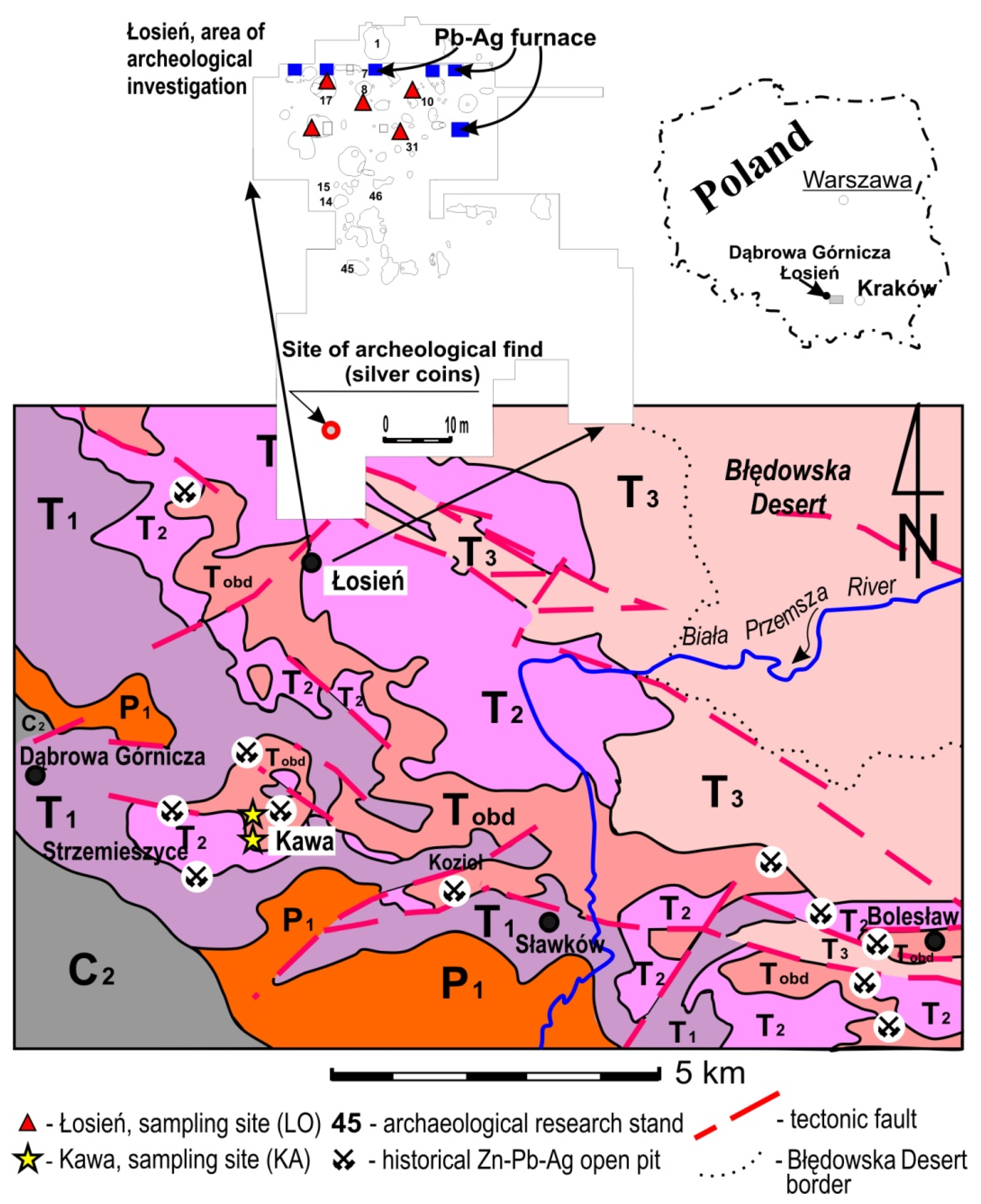
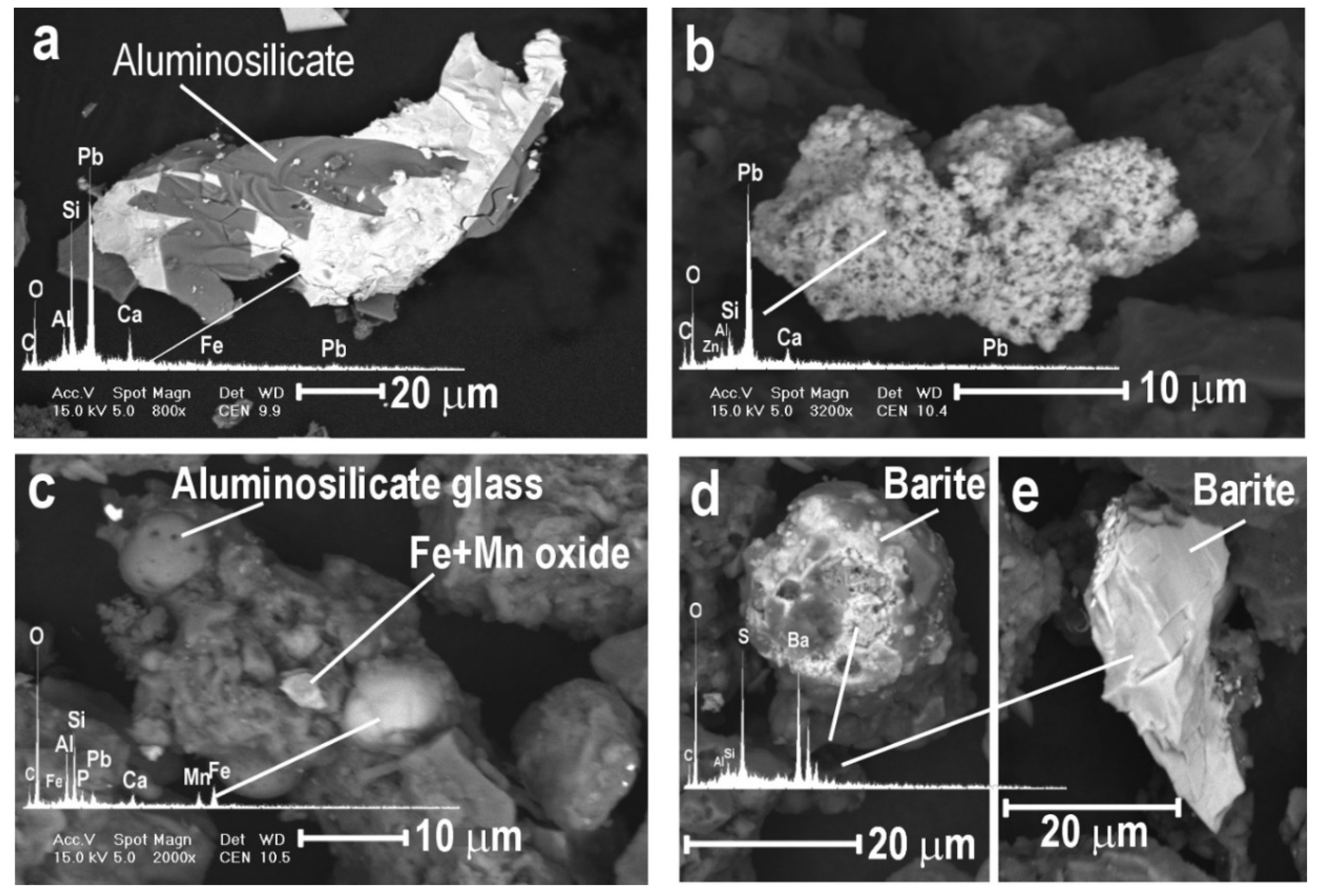
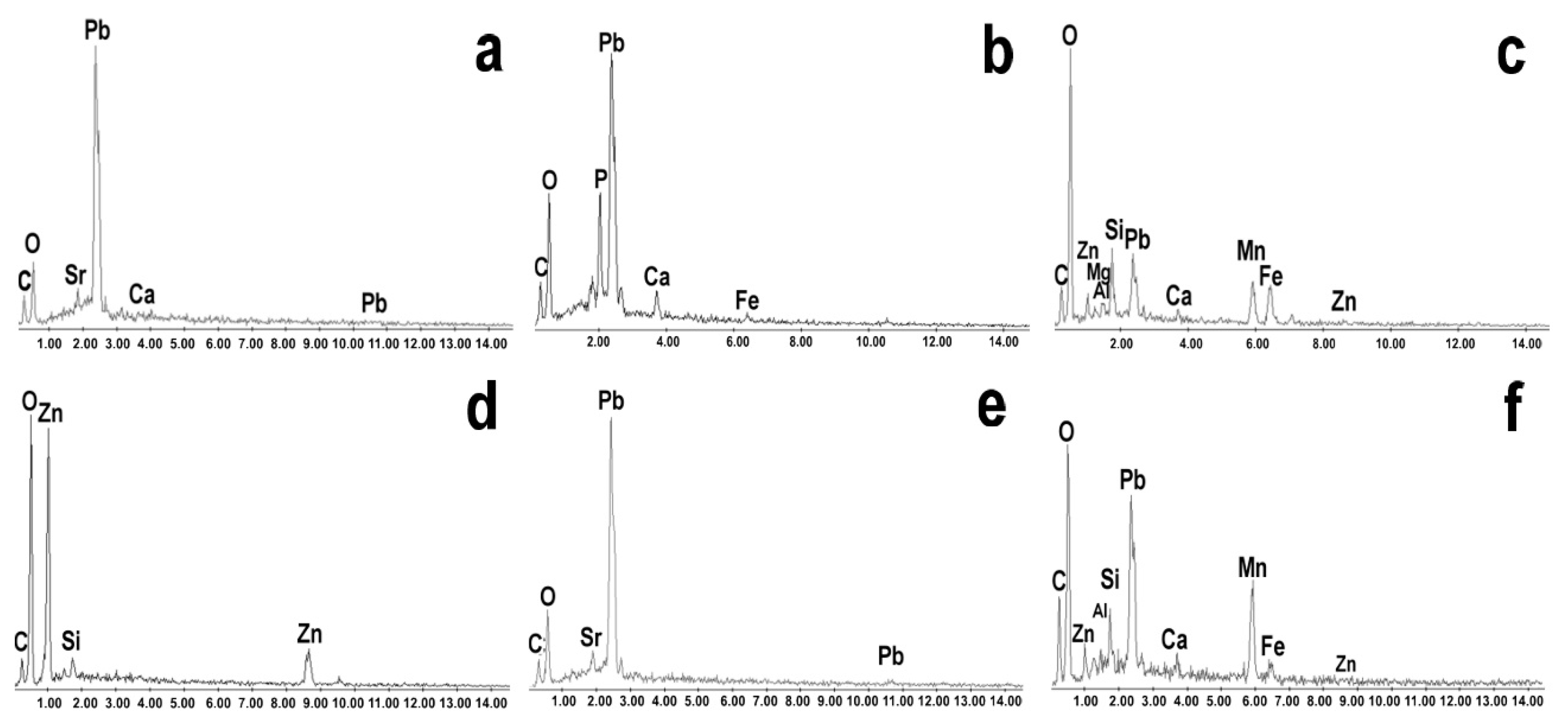
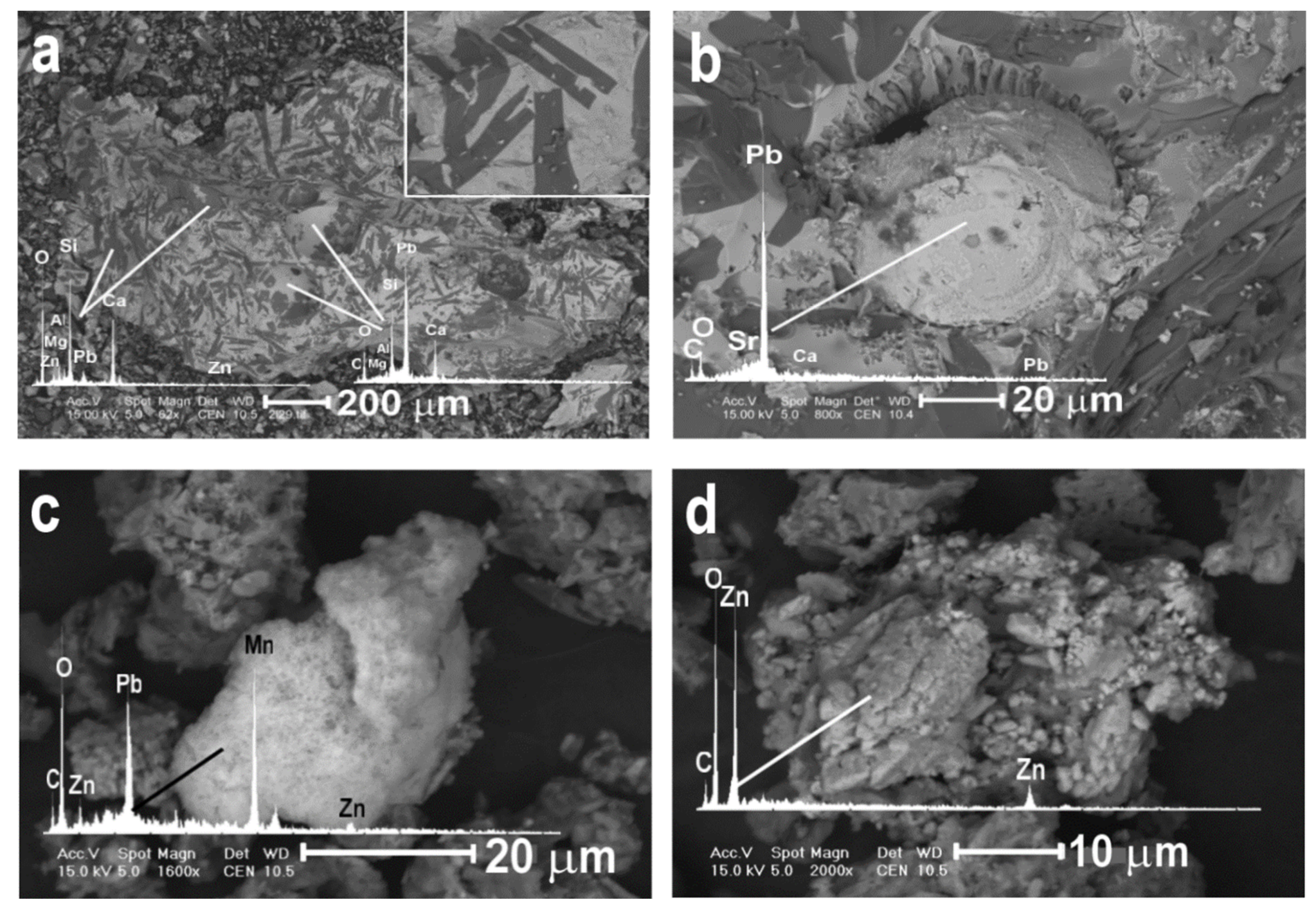
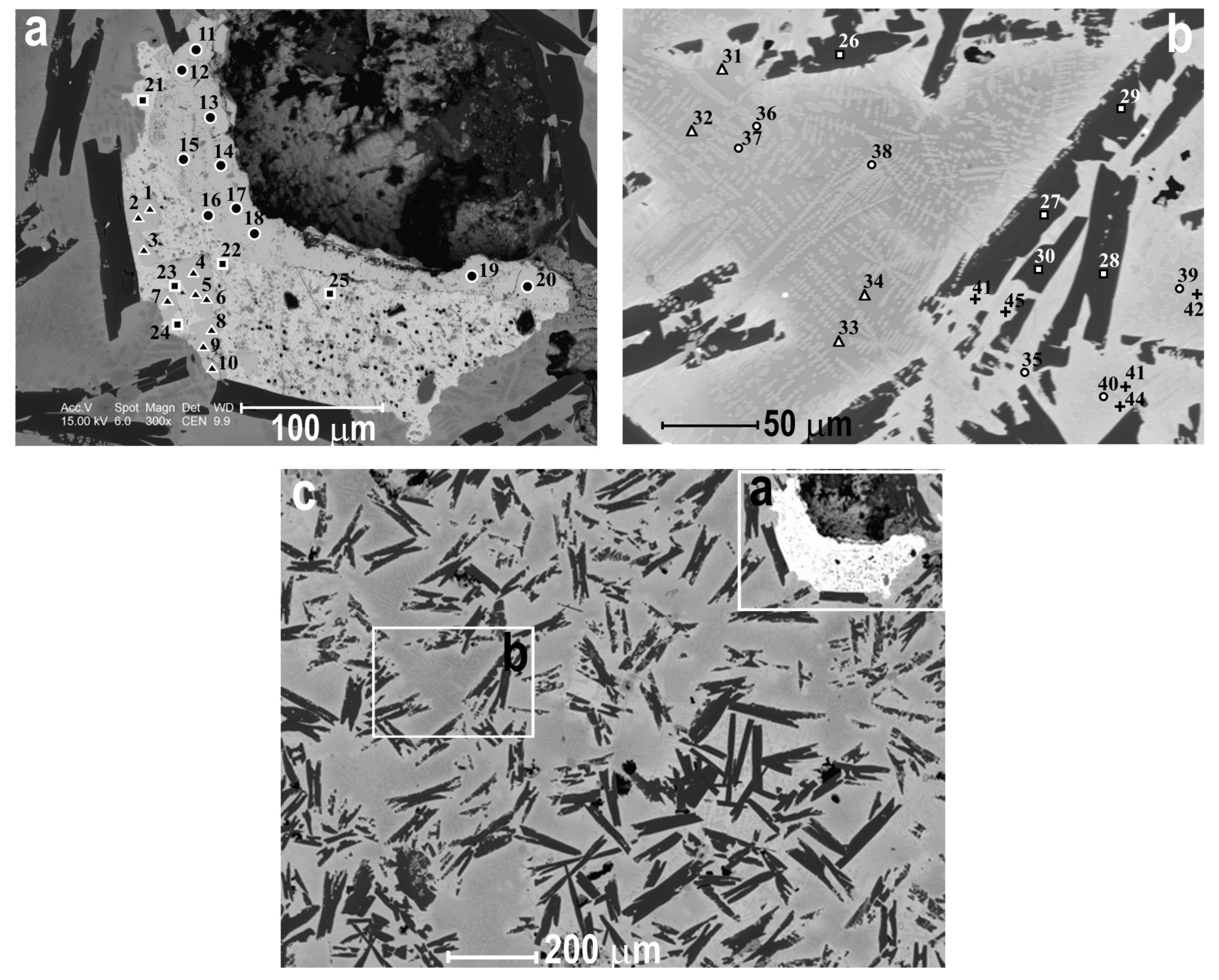
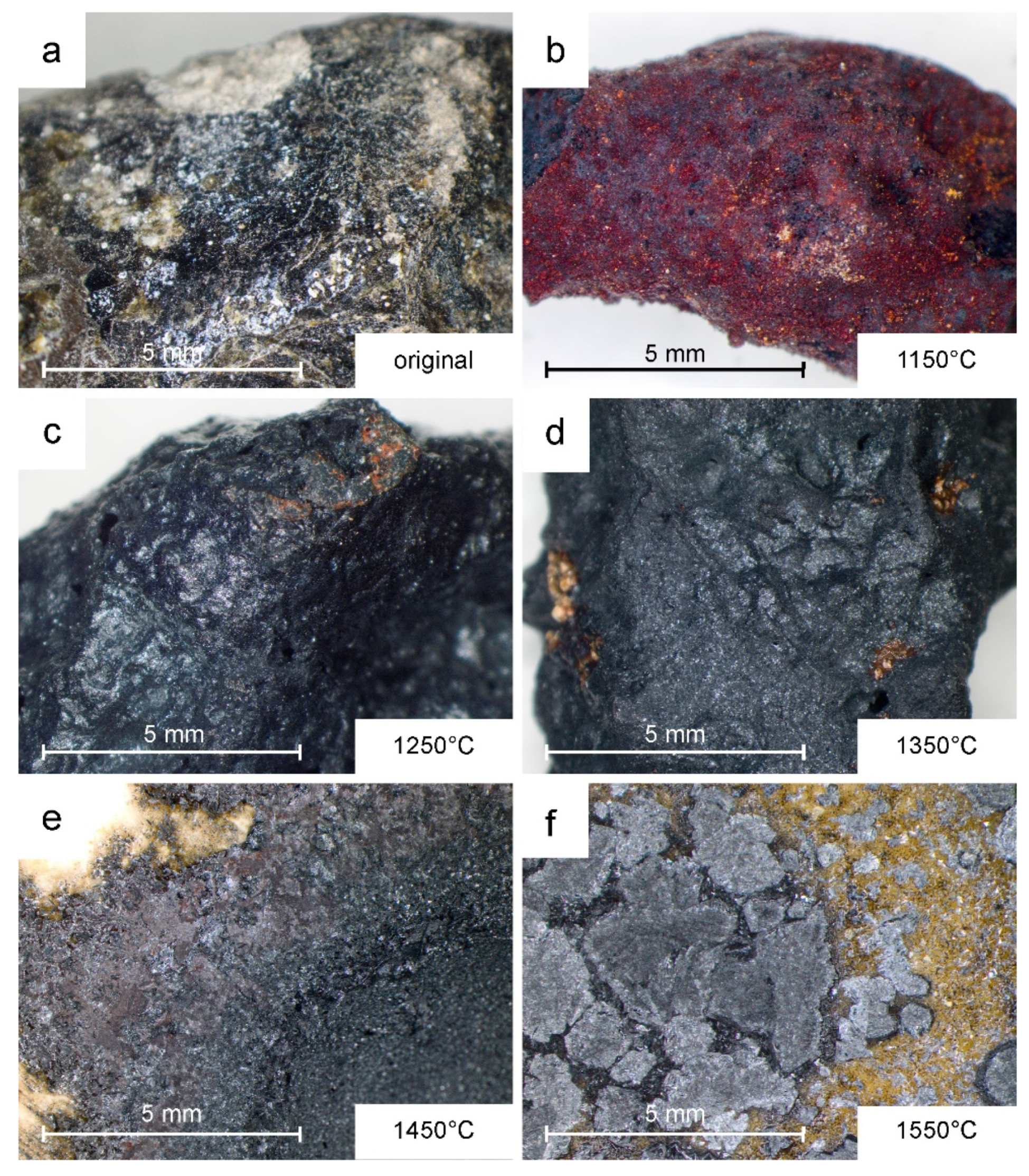
| Phase | Site | ||
|---|---|---|---|
| Pb-Ag Smelting, (12th Century) Łosień (LO) | Zn–Pb Washing Historical Wastes Kawa (KA) | Zn-Pb Mining, Historical Wastes Kawa (KA) | |
| Barren phase | illite, quartz, calcite, dolomite | dolomite, ankerite, calcite, illite, quartz, K-feldspar, | dolomite, calcite, quartz, ankerite, K, Na- feldspar, illite, kaolinite |
| Major metalliferous phase | litharge, cerussite, goethite | cerussite, smithsonite, goethite, galena | goethite, ferrihydrite, sphalerite, galena, smithsonite, minrecordite, cerussite, barite |
| Minor phase | magnetite, barite, SiO2, glassy silica, pyromorphite, metallic Pb, Pb slag, Ti oxide, mullite | Ca phosphate, Fe-Mn oxide, Mn oxide | gypsum, anglesite, jarosite, hemimorphite, magnetite |
| Phase | Analysis No. | Pb | S | O | Total |
|---|---|---|---|---|---|
| Gn | 1 | 86.58 | 13.57 | nd | 100.20 |
| Gn | 2 | 86.97 | 13.39 | nd | 100.48 |
| Gn | 3 | 86.05 | 13.54 | nd | 99.68 |
| Gn | 4 | 87.14 | 13.47 | nd | 100.64 |
| Gn | 5 | 87.74 | 13.45 | nd | 101.20 |
| Gn | 6 | 87.93 | 13.38 | nd | 101.35 |
| Gn | 7 | 86.45 | 13.26 | nd | 99.72 |
| Gn | 8 | 86.63 | 13.44 | nd | 100.09 |
| Gn | 9 | 87.58 | 13.37 | nd | 100.96 |
| Gn | 10 | 87.52 | 13.86 | nd | 101.45 |
| Lit | 11 | 93.40 | nd | 7.21 | 100.61 |
| Lit | 12 | 93.74 | nd | 7.23 | 100.98 |
| Lit | 13 | 93.71 | nd | 7.23 | 100.95 |
| Lit | 14 | 94.86 | nd | 7.32 | 102.18 |
| Lit | 15 | 94.71 | nd | 7.31 | 102.02 |
| Lit | 16 | 94.00 | nd | 7.25 | 101.26 |
| Lit | 17 | 93.08 | nd | 7.18 | 100.27 |
| Lit | 18 | 93.13 | nd | 7.19 | 100.32 |
| Lit | 19 | 92.35 | nd | 7.13 | 99.48 |
| Lit | 20 | 92.56 | nd | 7.14 | 99.70 |
| met. Pb | 21 | 100.66 | nd | nd | 100.66 |
| met. Pb | 22 | 99.86 | nd | nd | 99.86 |
| met. Pb | 23 | 100.97 | nd | nd | 100.97 |
| met. Pb | 24 | 100.93 | nd | nd | 100.93 |
| met. Pb | 25 | 100.05 | nd | nd | 100.05 |
| Phase | mel | mel | mel | mel | mel | gls | gls | gls | gls | Pb-lar | Pb-lar | Pb-lar | Pb-lar | Pb-lar | Pb-lar | gls | gls | gls | gls | gls |
|---|---|---|---|---|---|---|---|---|---|---|---|---|---|---|---|---|---|---|---|---|
| Analysis no | 26 | 27 | 28 | 29 | 30 | 31 | 32 | 33 | 34 | 35 | 36 | 37 | 38 | 39 | 40 | 41 | 42 | 43 | 44 | 45 |
| SO3 | b.d. | b.d.. | 0.04 | b.d.. | b.d.. | 0.06 | 0.07 | 0.02 | 0.04 | b.d. | b.d. | b.d. | b.d. | b.d. | b.d. | 0.12 | 0.04 | 0.03 | 0.01 | 0.17 |
| P2O5 | 0.13 | 0.03 | 0.10 | 0.12 | 0.07 | 0.46 | 0.57 | 0.75 | 0.50 | 1.66 | 1.67 | 1.89 | 1.15 | 2.73 | 1.24 | 0.32 | 0.30 | 0.26 | 0.43 | 0.22 |
| SiO2 | 36.71 | 37.11 | 38.36 | 37.16 | 37.65 | 23.53 | 24.17 | 24.99 | 25.75 | 18.17 | 18.88 | 18.92 | 19.67 | 18.13 | 18.13 | 20.65 | 22.64 | 23.28 | 20.60 | 20.40 |
| Al2O3 | 4.50 | 4.47 | 3.49 | 4.56 | 4.07 | 3.67 | 3.83 | 3.60 | 3.92 | 0.01 | b.d. | 0.02 | 0.59 | 0.41 | 0.62 | 4.38 | 4.22 | 4.11 | 3.75 | 4.30 |
| CaO | 32.95 | 33.50 | 34.42 | 33.59 | 33.85 | 12.25 | 12.45 | 14.31 | 13.85 | 21.33 | 23.28 | 23.79 | 21.09 | 20.60 | 17.34 | 6.85 | 9.40 | 9.28 | 8.17 | 6.03 |
| PbO | 8.61 | 6.82 | 6.34 | 8.04 | 6.55 | 52.00 | 50.51 | 47.51 | 46.72 | 58.25 | 54.62 | 53.53 | 55.59 | 55.82 | 60.40 | 61.72 | 55.39 | 56.59 | 62.86 | 63.23 |
| MgO | 5.77 | 5.67 | 6.68 | 5.99 | 5.88 | 1.38 | 1.56 | 1.81 | 1.97 | 0.02 | 0.12 | 0.13 | 0.26 | 0.19 | 0.07 | 0.08 | 1.16 | 0.74 | 0.15 | 0.11 |
| FeO | 1.98 | 2.20 | 1.53 | 1.76 | 2.09 | 2.26 | 2.54 | 2.40 | 2.36 | 0.24 | 0.26 | 0.22 | 0.37 | 0.60 | 0.44 | 2.61 | 2.59 | 2.25 | 2.04 | 2.15 |
| MnO | 0.27 | 0.39 | 0.25 | 0.32 | 0.33 | 0.24 | 0.23 | 0.37 | 0.21 | 0.09 | 0.03 | 0.07 | 0.05 | 0.14 | n.d. | 0.20 | 0.27 | 0.23 | 0.12 | 0.16 |
| ZnO | 5.54 | 6.24 | 5.96 | 5.91 | 5.89 | 1.22 | 1.36 | 1.52 | 1.84 | 0.07 | 0.02 | 0.18 | 0.33 | 0.26 | n.d. | 0.22 | 1.07 | 0.42 | 0.14 | 0.24 |
| K2O | 0.33 | 0.72 | 0.59 | 0.30 | 0.79 | 0.48 | 0.59 | 0.49 | 0.58 | 0.22 | 0.22 | 0.23 | 0.21 | 0.31 | 0.25 | 0.68 | 0.59 | 0.58 | 0.61 | 0.63 |
| Ag | b.d. | b.d. | b.d. | b.d. | b.d. | b.d. | b.d. | b.d. | b.d. | b.d. | b.d. | b.d. | b.d. | b.d. | b.d. | b.d. | b.d. | b.d. | b.d. | b.d. |
| Total | 96.79 | 97.15 | 97.76 | 97.75 | 97.17 | 97.55 | 97.88 | 97.77 | 97.74 | 100.06 | 99.10 | 98.98 | 99.31 | 99.19 | 98.49 | 97.83 | 97.67 | 97.77 | 98.88 | 97.64 |
| a.p.f.u. (atoms per formula unit) | ||||||||||||||||||||
| SO3 | 0.00 | 0.00 | 0.00 | 0.00 | 0.00 | 0.00 | 0.00 | 0.00 | 0.00 | 0.00 | 0.00 | |||||||||
| P2O5 | 0.00 | 0.00 | 0.00 | 0.00 | 0.00 | 0.00 | 0.00 | 0.00 | 0.00 | 0.00 | 0.00 | |||||||||
| SiO2 | 1.92 | 1.92 | 1.95 | 1.92 | 1.94 | 0.96 | 0.97 | 0.96 | 1.00 | 0.96 | 1.00 | |||||||||
| Al2O3 | 0.28 | 0.27 | 0.21 | 0.28 | 0.25 | 0.00 | 0.00 | 0.00 | 0.04 | 0.03 | 0.04 | |||||||||
| CaO | 1.85 | 1.85 | 1.87 | 1.86 | 1.86 | 1.21 | 1.28 | 1.30 | 1.14 | 1.17 | 1.02 | |||||||||
| PbO | 0.12 | 0.09 | 0.09 | 0.11 | 0.09 | 0.83 | 0.75 | 0.73 | 0.76 | 0.80 | 0.89 | |||||||||
| MgO | 0.45 | 0.44 | 0.51 | 0.46 | 0.45 | 0.00 | 0.01 | 0.01 | 0.02 | 0.02 | 0.01 | |||||||||
| FeO | 0.09 | 0.10 | 0.07 | 0.08 | 0.09 | 0.01 | 0.01 | 0.01 | 0.02 | 0.03 | 0.02 | |||||||||
| MnO | 0.01 | 0.02 | 0.01 | 0.01 | 0.01 | 0.00 | 0.00 | 0.00 | 0.00 | 0.01 | 0.00 | |||||||||
| ZnO | 0.21 | 0.24 | 0.22 | 0.23 | 0.22 | 0.00 | 0.00 | 0.01 | 0.01 | 0.01 | 0.00 | |||||||||
| K2O | 0.02 | 0.05 | 0.04 | 0.02 | 0.05 | 0.01 | 0.01 | 0.01 | 0.01 | 0.02 | 0.02 | |||||||||
| Ag | 0.00 | 0.00 | 0.00 | 0.00 | 0.00 | 0.00 | 0.00 | 0.00 | 0.00 | 0.00 | 0.00 | |||||||||
| Total | 4.95 | 4.97 | 4.96 | 4.96 | 4.97 | 3.04 | 3.04 | 3.04 | 2.99 | 3.04 | 2.99 | |||||||||
| Samples | Fraction mm | Zn | Pb | Fe | Mn | Cd |
|---|---|---|---|---|---|---|
| mg·kg−1 (STD) | ||||||
| Sites polluted by archeological investigations in areas of 12th century Ag-Pb smelting (Łosień) | ||||||
| LO | >0.71 | 287.5 (53) | 306.0 (206) | 9292.2 (779) | 422.1 (32) | 0.5 (0.5) |
| LO | >0.355 | 197.2 (27) | 861.6 (756) | 6544.5 (566) | 307.6 (39) | 0.4 (0.4) |
| LO | >0.180 | 189.1 (28) | 192.0 (137) | 6814.8 (331) | 305.5 (22) | 0.9 (1.1) |
| LO | >0.09 | 399.9 (21) | 549.6 (199) | 14,015.2 (910) | 691.9 (40) | 2.6 (0.5) |
| LO | >0.045 | 782.5 (88) | 1106.5 (304) | 21,713.5 (2847) | 1077.7 (144) | 4.7 (1.6) |
| LO | <0.045 | 557.4 (99) | 833.7 (6) | 16,328.4 (3470) | 719.5 (313) | 3.4 (1.7) |
| Sites polluted by Zn-Pb historical washing and mining processes (Kawa) | ||||||
| KA | >0.71 | 49,257.6 (32,175) | 18,923.0 (3356) | 49,676.9 (2314) | 2718.4 (1967) | 251.6 (91) |
| KA | >0.355 | 36,737.6 (8629) | 10,960.6 (8074) | 54,764.1 (18,358) | 2642.4 (1833) | 136.4 (52) |
| KA | >0.180 | 41,658.8 (10,600) | 12,980.5 (9446) | 59,389.5 (22,184) | 2869.4 (2102) | 137.7 (48) |
| KA | >0.09 | 64,408.7 (29,984) | 26,847.9 (22,520) | 72,722.6 (14,175) | 3208.8 (2046) | 219.9 (113) |
| KA | >0.045 | 58,352.1 (46,242) | 49,282.5 (51,362) | 70,620.7 (25,510) | 4297.7 (3884) | 287.1 (180) |
| KA | <0.045 | 16,917.5 (18,155) | 26,622.1 (33,426) | 43,437.3 (14,183) | 2326.9 (721) | 207.3 (164) |
© 2019 by the authors. Licensee MDPI, Basel, Switzerland. This article is an open access article distributed under the terms and conditions of the Creative Commons Attribution (CC BY) license (http://creativecommons.org/licenses/by/4.0/).
Share and Cite
Cabała, J.; Warchulski, R.; Rozmus, D.; Środek, D.; Szełęg, E. Pb-Rich Slags, Minerals, and Pollution Resulted from a Medieval Ag-Pb Smelting and Mining Operation in the Silesian-Cracovian Region (Southern Poland). Minerals 2020, 10, 28. https://doi.org/10.3390/min10010028
Cabała J, Warchulski R, Rozmus D, Środek D, Szełęg E. Pb-Rich Slags, Minerals, and Pollution Resulted from a Medieval Ag-Pb Smelting and Mining Operation in the Silesian-Cracovian Region (Southern Poland). Minerals. 2020; 10(1):28. https://doi.org/10.3390/min10010028
Chicago/Turabian StyleCabała, Jerzy, Rafał Warchulski, Dariusz Rozmus, Dorota Środek, and Eligiusz Szełęg. 2020. "Pb-Rich Slags, Minerals, and Pollution Resulted from a Medieval Ag-Pb Smelting and Mining Operation in the Silesian-Cracovian Region (Southern Poland)" Minerals 10, no. 1: 28. https://doi.org/10.3390/min10010028
APA StyleCabała, J., Warchulski, R., Rozmus, D., Środek, D., & Szełęg, E. (2020). Pb-Rich Slags, Minerals, and Pollution Resulted from a Medieval Ag-Pb Smelting and Mining Operation in the Silesian-Cracovian Region (Southern Poland). Minerals, 10(1), 28. https://doi.org/10.3390/min10010028





